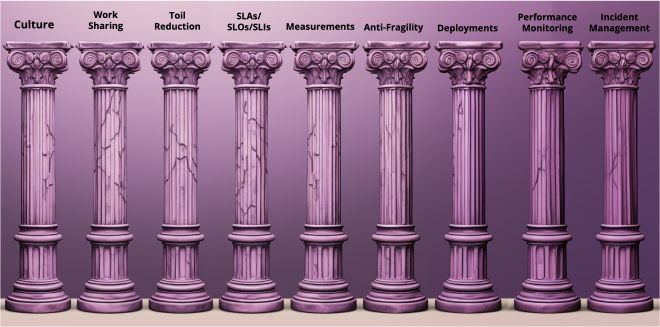How OpenShift Fulfills the 9 Pillars of SRE Practices
Table of Contents
Introduction #
Hello MeatyBytes.io readers! I’m Nick Miethe, your guide into the meaty world of Platform Engineering and DevOps. As a dedicated OpenShift architect and a self-confessed tech-enthusiast, I find pleasure in uncovering the myriad ways that technology can transform our work and hobbies.
Today, we’re diving deep into the synergy between OpenShift and the ‘9 Pillars of SRE Practices’, as defined by Marc Hornbeek in his insightful 2021 blog post. If you’re involved in DevOps, SRE, or any related field, these pillars (or similar) are likely central to your practice. As we’ll explore in this article, OpenShift not only aligns well with these principles but can act as a robust platform to implement them.
Synopsis #
The significance of these pillars in managing service reliability and why OpenShift is an ideal platform to enable them, forms the crux of our discussion today. We’ll look at each pillar - Continuous Improvement, Automation, Monitoring and Measurement, Incident Response, Change Management, Service Level Objectives (SLOs), Disaster Recovery, Capacity Planning, and Performance Efficiency - and demonstrate how OpenShift empowers these practices.

We’ll start by understanding the philosophy of Site Reliability Engineering (SRE), before moving on to the meat of the subject - the ‘9 Pillars’ themselves. You’ll get a thorough understanding of how OpenShift serves each pillar, with practical examples and specific use cases. By the end of this post, you’ll gain valuable insights on how OpenShift can elevate your organization’s SRE practices to the next level, ensuring a smooth, reliable, and efficient DevSecOps experience.
Ready to dive into the meaty world of OpenShift and SRE practices? Let’s get started!
Culture #
OpenShift promotes a culture of collaboration and transparency between developers and operations teams. With built-in CI/CD pipelines, integrated developer tools, and a unified console, OpenShift encourages a DevOps mindset. This means you’re fostering a culture where shared responsibilities, frequent communication, and continuous learning are valued.
Work Sharing #
OpenShift supports an environment where work sharing is made simple. Its Kubernetes-based orchestration allows for declarative configurations and desired state management, reducing manual interventions. This frees up time for teams to focus on higher-value tasks, fostering a more efficient work sharing system.
Toil Reduction #
Toil is the kind of work tied to running a production service that is manual, repetitive, automatable, tactical, devoid of enduring value, and scales linearly as a service grows. OpenShift helps reduce toil through automation of service deployments and scaling with Kubernetes. Further toil reduction is achieved through its Operator Framework, enabling the automation of routine tasks.
SLAs/SLOs/SLIs #
OpenShift supports robust monitoring and alerting mechanisms with tools like Prometheus and Grafana. These capabilities allow SREs to accurately define and measure Service Level Indicators (SLIs), Objectives (SLOs), and Agreements (SLAs). They provide the insight necessary to proactively address issues before they impact SLAs.
Measurements #
OpenShift provides comprehensive logging, monitoring, and tracing capabilities. From in-built Elasticsearch for log aggregation, to Jaeger for request tracing, and the previously mentioned Prometheus for metrics collection, OpenShift ensures you have the measurements you need to understand system behavior and drive decision making.
Anti-Fragility #
OpenShift is designed to be resilient and self-healing. It does this through features like auto-scaling, automated rollouts and rollbacks, and self-healing applications. This inherent anti-fragility means your platform gets stronger and more robust with every failure and subsequent recovery.
Deployments #
OpenShift’s Kubernetes-powered deployments provide a repeatable, reliable, and incremental update to applications. Blue-green and canary deployments are supported natively. These capabilities allow SREs to minimize the impact of faulty releases and ensure rapid rollback when necessary.
Performance Management #
OpenShift has inbuilt horizontal and vertical scaling capabilities that respond in real-time to workload changes. Combined with the platform’s comprehensive observability features, this allows for effective performance management, ensuring your applications always meet their performance targets.
Incidents Management #
When incidents occur, OpenShift’s inbuilt logging and monitoring capabilities can help identify the cause. Additionally, OpenShift’s Kubernetes-based architecture and API-driven design make it compatible with a wide range of incident management tools in the ecosystem. This means you can integrate with the tools your teams are comfortable with, ensuring swift incident resolution.
Conclusion #
OpenShift is not just a container orchestration platform. It’s a tool that embraces and enables the key principles of SRE practices. Whether it’s fostering a cooperative culture, reducing toil, facilitating effective incident management, or any of the other SRE pillars, OpenShift has you covered. With its rich feature set and Kubernetes-backed power, it is poised to be the trusted companion of every SRE team.
That’s it for today, but stay tuned for our next post with the Meaty guarantee to sate your thirst for knowledge!
References #
For further reading on OpenShift and SRE practices, consider the following resources:
- Rapid Strategic SRE Assessments Accelerate IT Transformations - DevOps.com - Marc Hornbeek
- Google - Site Reliability Engineering Handbook
- The Site Reliability Workbook: Practical Ways to Implement SRE by Betsy Beyer et al
- Operating OpenShift: An SRE Approach to Managing Infrastructure by Rick Rackow and Manuel Dewald
